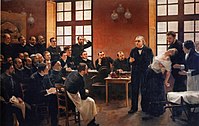
Photo from wikipedia
OBJECTIVE Stroke remains the leading cause of disability in the United States. Even as acute care for strokes advances, there are limited options for improving function once the patient reaches… Click to show full abstract
OBJECTIVE Stroke remains the leading cause of disability in the United States. Even as acute care for strokes advances, there are limited options for improving function once the patient reaches the subacute and chronic stages. Identification of new therapeutic approaches is critical. Deep brain stimulation (DBS) holds promise for these patients. A number of case reports and small case series have reported improvement in movement disorders after strokes in patients treated with DBS. In this systematic review, the authors have summarized the patient characteristics, anatomical targets, stimulation parameters, and outcomes of patients who have undergone DBS treatment for poststroke movement disorders. METHODS The Preferred Reporting Items for Systematic Reviews and Meta-Analyses (PRISMA) guidelines were followed. The PubMed, Scopus, and SpringerLink databases were searched for the keywords "DBS," "stroke," "movement," and "recovery" to identify patients treated with DBS for movement disorders after a stroke. The Joanna Briggs Institute Critical Appraisal checklists for case reports and case series were used to systematically analyze the quality of the included studies. Data collected from each study included patient demographic characteristics, stroke diagnosis, movement disorder, DBS target, stimulation parameters, complications, and outcomes. RESULTS The authors included 29 studies that described 53 patients who underwent placement of 82 total electrodes. Movement disorders included tremor (n = 18), dystonia (n = 18), hemiballism (n = 6), spastic hemiparesis (n = 1), chorea (n = 1), and mixed disorders (n = 9). The most common DBS targets were the globus pallidus internus (n = 32), ventral intermediate nucleus of thalamus (n = 25), and subthalamic area/subthalamic nucleus (n = 7). Monopolar stimulation was reported in 43 leads and bipolar stimulation in 13. High-frequency stimulation was used in 57 leads and low-frequency stimulation in 6. All patients but 1 had improvement in their movement disorders. Two complications were reported: speech impairment in 1 patient and hardware infection in another. The median (interquartile range) duration between stroke and DBS treatment was 6.5 (2.1-15.8) years. CONCLUSIONS This is the first systematic review of DBS for poststroke movement disorders. Overall, most studies to date have been case reports and small series reporting heterogeneous patients and surgical strategies. This review suggests that DBS for movement disorders after a stroke has the potential to be effective and safe for diverse patients, and DBS may be a feasible option to improve function even years after a stroke.
Journal Title: Journal of neurosurgery
Year Published: 2022
Link to full text (if available)
Share on Social Media: Sign Up to like & get
recommendations!